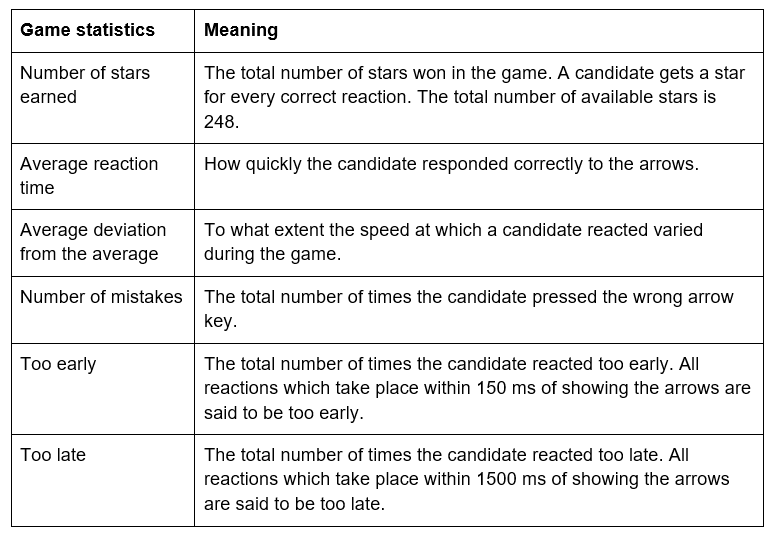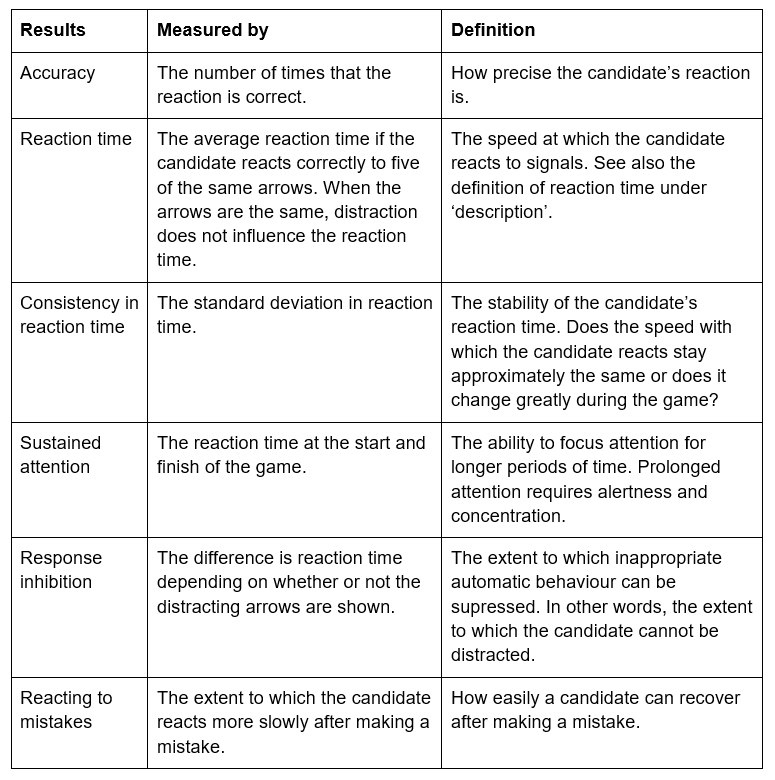Factsheet Psychometric Game ‘Rally’
The ‘Rally’ game measures reaction time and response inhibition.
Description
‘Rally’ is a psychometric game. A psychometric game combines a psychometric test with game technology. It measures a psychological construct such as an individual skill, capacity or characteristic. Scientifically robust methods are used to measure the construct.
The ‘Rally’ game is based on the neuropsychological test, the Flanker task (Eriksen & Eriksen, 1974). The Flanker task is used in science and in psychodiagnostics to measure response inhibition. Game elements are added to this neuropsychological test to motivate and enthuse candidates. The candidate is absorbed in playing the game (this is referred to as ‘flow’) and is therefore less aware of the assessment element. The game results thus better reflect the candidate’s best performance. A big advantage of using a game is that it improves the candidate experience. Using a game and game technology also means that response inhibition can be measured more accurately, so that a greater amount of data can be collected in a shorter period of time./p>
Measurement pretensions
The ‘Rally’ game measures reaction time and response inhibition.
-
Reaction time is the time interval between the presentation of a change and the execution of the appropriate response to that change. The speed at which someone reacts depends on how quickly they observe, process and react to the change. Reaction time is therefore also important for responding appropriately and on time to situations in our daily lives. For example, a traffic light that jumps to red; the firing of the starting gun in a marathon; having to react quickly to an alarm going off.
-
Response inhibition is the ability to supress inappropriate or no longer necessary behaviour. Without inhibition, people give in to their impulses, habits, automatic behaviour or environmental stimuli. The ability to exercise control is crucial to being able to act purposefully. An example is the ability to keep focused on work at the office whilst the emails keep coming in; or reacting in a conversation only after the other person has given all the information; the ability to ignore unwanted thoughts or memories.
Use
The ‘Rally’ game can be applied to all contexts, both selection and advisory, in which reaction time and/or response inhibition are important. Response inhibition is important for targeted action and is therefore a part of everyday life. In certain professions, such as the police, fire fighting, the military and security, it is extremely important to be able supress impulses. Reaction time can be measured for certain professions where quick reactions are important. For example for jobs in the transport sector.
Development
This game was developed to measure response inhibition and reaction time. This game is based on the Flanker task neuropsychological test. Game elements such as graphics, levels, rewards and feedback were added to the test. This test was adapted after conducting three qualitative pilot studies. Based on the feedback and experience from game participants, the most important adjustment was that the game’s level of difficulty increases faster. A usability study was also carried out to ensure that the game was in line with the target group, the general Dutch workforce. User experience and game interpretation were analysed by conducting interviews (thinking-out-loud and probing interviews) with people (N = 23) from various cultural backgrounds, educational levels, age, and game and computer experience. The results of this study formed the basis of improvements to the game and the tutorials, thus making the game accessible to everybody.
Reference group
The current reference group is based on data collected from research. This sample (N = 172) is representative of the Dutch labour force in terms of work situation (working or not working), gender, age and educational level.
How to read the report
The report gives the results of all the games that the candidate has completed. The report begins with a summary. The summary gives an outline of the results of all the games completed. Per game, the statistics and results are then explained in more detail. This fact sheet provides an explanation of the results of the ‘Rally’ game. For an explanation of the results of other games, see the Psychometric Game, ‘Barista’, Blocks’ and ‘Connect’ fact sheets.
Summary
This shows the overall performance of each game. This is shown as a graph, with on the y-axis accuracy as a sten score and the x-axis reaction time as a sten score.

Game statistics
The game statistics provide general information about how well the game was played. The following game statistics are reported for the ‘Rally’ game:

Results
The results provide information about characteristics based on how the game was played. The results are expressed as sten scores. Sten scores are standard scores with an average of 5.5 and a standard deviation of 2. Sten scores show how the candidate’s scores relate to the reference group. Which results are reported, how these are measured and their definitions are shown below.

References
Mayer, J., Roberts, R. D., & Barsade, S. G. (2008). Human abilities: Emotional intelligence. Annual Review of Psychology, 59, 507–536.
Van Rooy, D. L., Viswesvaran, C., & Pluta, P. (2005). An evaluation of construct validity: What is this thing called emotional intelligence. Human Performance, 18, 445–462. 10.1207/s15327043hup1804_9.
Zeidner, M., Roberts, R. D., & Matthews, G. (2008). The science of emotional intelligence: Current consensus and controversies. European Psychologist, 13, 64–78.
